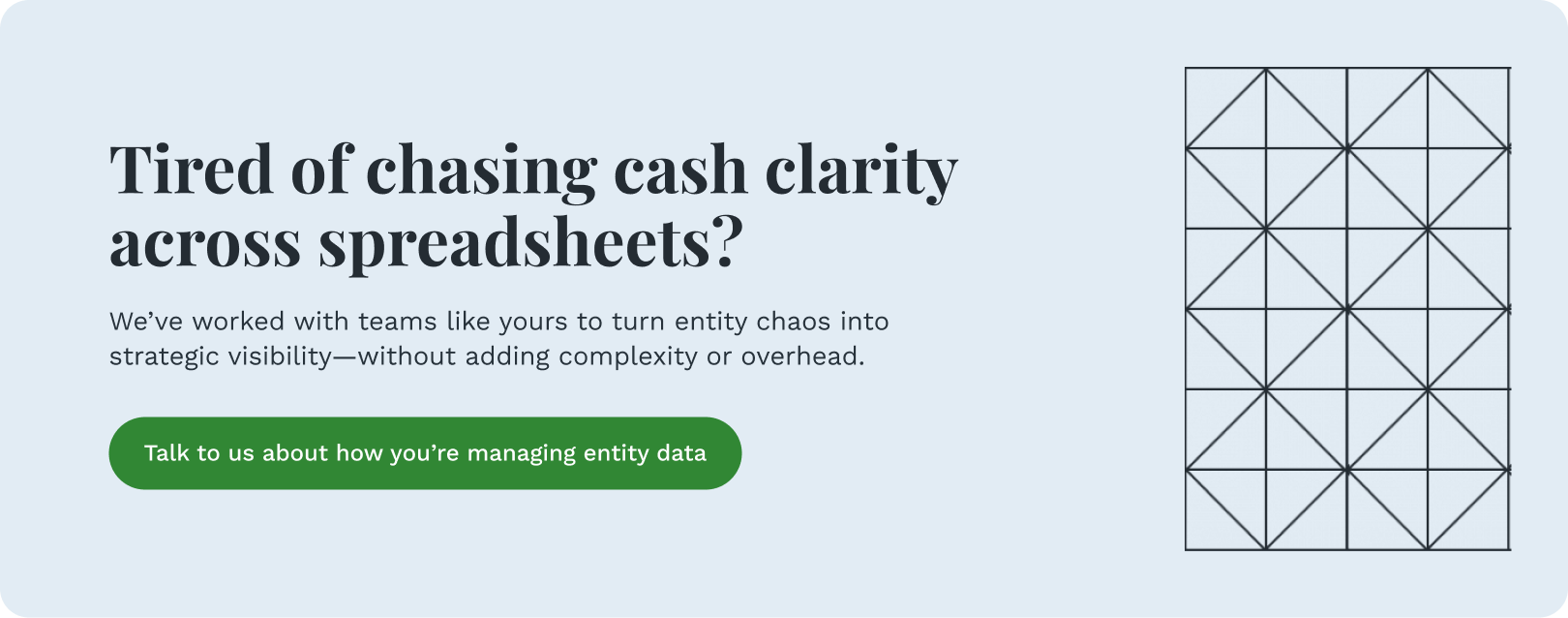Why Practitioners Struggle to Answer Basic Cash Questions—and What to Do About It
If you’re a treasurer, you’ve probably had one of those mornings.
You’re building a cash forecast, pulling together a liquidity snapshot, or prepping for a board review—and suddenly, you’re stuck. Not because you don’t know what to do, but because the entity data won’t cooperate.
No time to read? Here's what you need to know.
- Scattered entity records cost time, confidence, and strategic agility.
- Practitioners suffer most—but CFOs and the business pay the price.
- Proof points show tangible savings in time, audit readiness, and cash precision.
- Cash and treasury platforms can transform reactive processes into proactive strategy—powered by structured, real-time data.
If you’re still relying on spreadsheets to explain where your cash is, this article will show you what that’s really costing you—and how to fix it.
The cash balance in the ERP doesn’t match what’s in your spreadsheet. Two entities have nearly identical names—but different bank accounts. You’re pinging tax for ownership details, legal for signatory authority, and accounting to confirm intercompany positions. Meanwhile, the CFO is asking if cash is available for a debt payment, and all you’ve got is a half-built report and four open tabs of conflicting data.
It’s not just annoying.
It’s expensive.
Because when you’re chasing down entity-level clarity, you’re not managing cash—you’re managing chaos. And that chaos slows down reporting, undermines forecasts, and chips away at the confidence your leadership needs to make high-stakes decisions.
Why Treasurers Are Feeling the Strain
If you manage cash or reporting across multiple business units, entities, or bank accounts, scattered data isn’t just frustrating—it’s dangerous. Entity records form the backbone of your cash intelligence. When they’re fragmented, it touches everything:
- Daily liquidity snapshots
- Rolling 13-week forecasts
- Intercompany settlements
- FX exposure analysis
- Debt coverage and compliance reporting
Every one of these workflows is slowed down, weakened, or compromised by inconsistent or inaccessible entity data.
Can You Deliver a Reliable Global Cash Position in Under 30 Minutes?
Most practitioners can’t deliver a real-time global cash position in under an hour—and it’s not because they lack skill. It’s because the data is fractured.
According to a 2024 survey by Strategic Treasurer, 77% of organizations still use Excel spreadsheets as their primary tool for cash positioning and forecasting. This manual process adds friction and delays across the board.These delays don’t just impact productivity—they slow down executive decisions and introduce risk at the worst possible time.
When your CFO asks, “How much unrestricted cash do we have across all entities?” and you need half a day to validate that number, you're not enabling decisions—you’re slowing them down.
Here's the Proof: Inaccurate Entity Data Disrupts Forecasting
Short-term cash forecasting is only as strong as the data behind it. And for most finance and treasury teams, that data is scattered.
When you’re pulling data from spreadsheets, reconciling it manually, or relying on outdated general ledger mappings, the margin for error grows fast. You’re forced to pad forecasts with overly conservative buffers or scramble to explain last-minute variances. And that makes it harder to answer critical questions with confidence—like whether cash is available for debt service, expansion, or shareholder returns.
Treasury leaders are left working with fragmented inputs and fragile assumptions. They're left with forecasts that look complete on the surface, but can’t hold up under pressure. And when strategy depends on those numbers, that’s a risk no one can afford.
Why This Pain Point Is So Costly
1. Slows Down Forecasting Cycles
Without clean, structured entity data, forecasting takes longer and requires constant validation. That lag prevents scenario planning around debt repayments, dividend timing, or working capital optimization.
And here’s what that actually costs you: missed chances to rebalance capital, slower strategic moves, and a CFO who’s stuck reacting instead of leading with clarity.
2. Inflates Compliance and Audit Risk
When entity information is stored in siloed systems—or worse, across employee-maintained Excel files—verifying regulatory compliance (e.g., KYC, SOX, Basel III) becomes time-consuming and error-prone.
The risk you run: Gaps in control, delayed filings, and elevated exposure to fraud—especially when outdated entity details go unnoticed until it’s too late.
3. Creates FX and Intercompany Exposure
Poorly structured entity data obscures intercompany flows, leading to duplicate payments, trapped cash, or mismatched hedging strategies. FX losses often stem not from bad execution—but bad visibility.
When that visibility is missing: Unhedged positions and costly currency translation variances become the norm—not the exception. It’s exposure you could have avoided, if the data had told the full story.
4. Damages Your Strategic Credibility
The cost isn’t just financial. When executives consistently get delayed or caveated answers, they start questioning the reliability of treasury and finance—not just the data.
What this means in practice: Once that trust erodes, so does your influence. Without credibility, you’re no longer seen as a strategic partner—you’re seen as a source of friction. And that means fewer opportunities to shape decisions, challenge assumptions, or drive the conversation forward.
The Real Problem: Spreadsheets Can’t Scale With Your Entity Structure
As your organization grows—organically or through M&A—your entity structure becomes more complex. But if you’re still managing that complexity through manually maintained spreadsheets, you’re gambling with visibility.
Excel isn’t the enemy. But it’s not an entity management platform. It doesn’t offer:
- Real-time consolidation
- Bank integration
- Workflow automation
- Role-based access and controls
- Built-in audit trails
You can’t scale strategic reporting with a tool designed for ad hoc calculation.
The Solution: Cash & Treasury Platforms Built for Entity-Level Cash Control
Modern treasury platforms are engineered to bring order to entity chaos—and unlock the visibility that treasury and finance teams need to move from reactive to strategic.
Here’s how they help treasurers specifically:
Real-Time Cash Visibility by Entity
Instead of manually pulling balances from six banks and a dozen accounts, modern treasury platforms connect directly to financial institutions and internal systems—automatically aggregating cash by legal entity, region, and currency.
This shift doesn’t just save time; it creates a reliable, up-to-date foundation for decision-making that spreadsheets and disconnected systems simply can’t provide.
Structured Entity Record Management
All legal entities, banking relationships, signatory details, and intercompany linkages are stored in one place, not across fragmented folders.
- View ownership hierarchies
- Validate payment authority
- Prevent double-counting across subsidiaries
When your records are structured and accessible, internal audit prep becomes faster, cleaner, and far less stressful. Teams that centralize entity data often report saving a significant amount of time during audits—turning what used to be a fire drill into a routine check.
Forecasting and Scenario Modeling Tied to Entity Logic
Want to test what happens if a European entity delays a dividend, or if a U.S. sub takes on new debt? Modern cash and treasury solutions lets you simulate cash impact across entities in real-time—without recreating spreadsheets.
Use case: A tech company used a treasury platform to model cash flow impact of a regional tax payment shift, identifying a $12M short-term liquidity gap weeks ahead of time.
Audit Trails and Controls Built for Finance
Every action is tracked. Every payment confirmed. Every report linked to the source data. No more hunting through email threads or SharePoint folders to explain variances.
When cash and entity data are housed in audit-ready systems, CFOs gain more than just operational efficiency—they gain credibility. Reviews run cleaner, questions are easier to answer, and board conversations shift from explaining the past to planning for the future.
How This Helps Your CFO (and How to Make the Case)
Practitioners feel the operational pain, but CFOs face the strategic consequences.
If you want to make the business case for investing in a modern treasury platform, frame it around what’s keeping your CFO up at night:
CFO Priority: Reliable Liquidity Visibility
“How much cash do we have? Where is it? Can we move it?”
- Pain: Current reports are outdated, entity-level insights are inconsistent, and trapped cash isn’t visible until it’s too late.
- Solution: Real-time dashboards that aggregate balances across all legal entities and currencies, enabling faster, informed cash deployment.
CFO Priority: Confident Decision-Making
“Can we fund this acquisition, repay this debt, or accelerate hiring—without risking cash flow?”
- Pain: Forecasts are built manually, using inconsistent data and delayed inputs.
- Solution: Dynamic forecasting tools that draw from structured entity records, allowing on-the-fly scenario planning.
CFO Priority: Faster Close, Fewer Surprises
“Why does the close still take 12 days? And why do the numbers keep changing?”
- Pain: Manual processes, misaligned entity records, and last-minute reconciliation derail timelines and shake confidence.
- Solution: Consolidated systems, automated controls, and structured data models enable faster close and cleaner audits.
Final Word: Fix the Foundation, Elevate the Function
Treasurers are the engine behind every meaningful financial insight. But when your engine is fueled by scattered, stale, or incomplete entity data, it doesn’t matter how skilled you are—you’ll always be playing catch-up.
By investing in a platform built for cash visibility at the entity level, you:
- Save hours of work every week
- Eliminate preventable errors
- Enable faster, smarter decisions
- Become a strategic partner—not a reporting bottleneck


